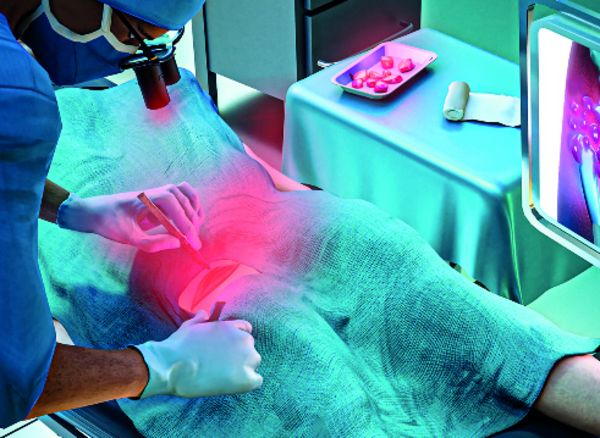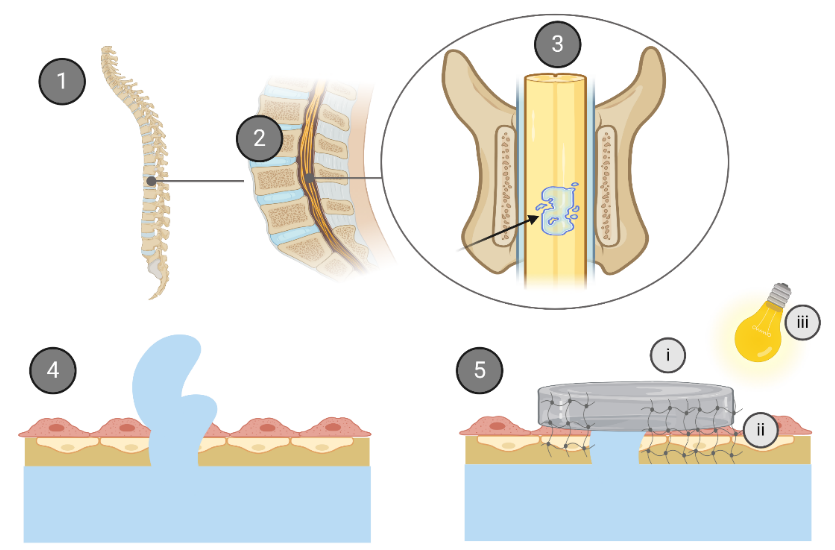Research in Orthopedics
Transforming Healthcare through Innovative Medical Materials & Technology

At the Balgrist Ingenuity Lab we are transforming patient care by developing advanced materials and devices that enhance therapeutic outcomes, improve diagnostic precision, and expedite recovery. By harnessing the unique properties of materials, this research centered on musculoskeletal soft tissue aims to create integrated solutions that not only treat but also monitor health conditions in real-time.
Wound Healing with Nanoglue
Medical materials are having a transformative impact in numerous fields, including wound healing. One of our most promising innovations involves the use of mixed metal oxide nanoparticles, specifically those based on cerium oxide and bioglass. These materials support the different phases of wound healing through a multifaceted approach that promotes tissue regeneration and offers antimicrobial activity. Cerium oxide nanoparticles have been identified for their exceptional catalytic properties, which can effectively neutralize or generate reactive oxygen species, depending on the local microenvironment. While this reduces inflammation and promotes a more conducive environment for healing, the catalytic activity of nanoparticles also introduces a novel mechanism for antimicrobial defense, which is crucial in preventing infection. Our research shows that ceria/bioglass nanoparticles can even eliminate bacterial pathogens hiding within immune cells, thus preventing infection relapse. Bioglass complements this by dissolving in physiological conditions to release ions such as calcium and silicon, which are known to stimulate the growth of new bone and connective tissue. This synergy between cerium oxide and bioglass encourages rapid and improved healing outcomes, addressing both the biological and mechanical aspects of wound repair of both soft and hard tissues.
Nanocatalysts for the Treatment of Resistant Sarcoma
Nanoscale materials engineering can not only be leveraged to heal wounds. Another promising area is the use of (radio)catalytically active metal oxides to enhance the efficacy of radio- and proton-therapy in oncology. We have discovered that titanium-based materials, when introduced to tumor tissues, can potentially augment the therapeutic effects of radiation by generating localized oxidative stress. This stress can increase the susceptibility of cancer cells to radiation, thereby reducing the required dose and minimizing collateral damage to surrounding healthy tissues. The specific targeting provided by these metal oxides opens up new avenues for personalized cancer treatment, offering a tailored therapeutic approach based on the unique properties of the tumor environment. This strategy not only improves the effectiveness of existing treatments but also reduces the side effects associated with high doses of radiation. Together with radiation oncology experts, we are currently investigating this new approach in patient-derived tumor tissues.
Nanomaterials that Make the Invisible Visible
Carefully engineered materials enable the acquisition of information that is not visible to the naked eye. The development of fluorescent inorganic materials that operate in the near-infrared spectral regions represents a significant advance in medical imaging. These materials can be used to measure blood perfusion, as well as to distinguish tumor cells from healthy tissues intraoperatively, thus providing critical information on tissue viability and the effectiveness of various treatments. The ability to operate in the nearinfrared windows is particularly advantageous, because these wavelengths penetrate deeper into tissues, offering clearer and more detailed images. This technology has profound implications for surgical and post-operative monitoring, allowing surgeons to assess and respond to changes in blood flow and tissue health in real time. Such capabilities are crucial in surgeries where blood perfusion is a key indicator of tissue viability, such as in wound management and reconstructive surgery. Moreover, the use of these fluorescent materials extends beyond traditional imaging. They can be integrated into therapeutic regimens to provide real-time feedback on the delivery and distribution of drugs or to guide intraoperative procedures, such as laser tissue soldering. This integration of diagnostic and therapeutic functionalities not only enhances the precision of treatments but also enables minimally invasive treatment approaches.
High-Performance Smart Tissue Adhesives
Materials can also be designed to replace or augment native tissue function in diseased tissues. The development of high-performance smart hydrogel adhesives for dural and tendon repair is addressing an important medical need. At the Ingenuity Lab, we have invented a unique approach for achieving strong tissue adhesion. These hydrogel adhesives are crafted to provide strong, flexible bonds capable of withstanding the mechanical demands of the body's moving parts. Moreover, these smart adhesives employ “molecular stitching” technology, which facilitates seamless tissue integration. This approach enhances the natural healing process, allowing the adhesive to interlock at the molecular level with the tissue structure, thus providing a more natural and durable repair. This molecular integration not only ensures that the repair is robust and long-lasting but also reduces the likelihood of the body rejecting the adhesive. In addition to their primary repair functions, these innovative adhesives can be loaded with therapeutic agents to further support the healing process. This targeted delivery system is especially beneficial in critical repair scenarios, such as in spinal or orthopedic surgeries, where localized therapy can significantly enhance outcomes. Furthermore, the integration of diagnostic capabilities within these adhesives adds a layer of intelligence to surgical repairs. Sensors embedded within the adhesives can monitor mechanical stress, pH levels, or other biochemical markers
relevant to the healing process, providing real-time feedback to medical professionals. This information can be critical in adjusting treatment plans post-surgery and ensuring optimal recovery. Overall, the development of these smart tissue adhesives the Ingenuity Lab represents a significant leap forward in biomedical engineering. By combining mechanical support, biological enhancement, therapeutic treatment, and diagnostic monitoring into a single, sophisticated material, these adhesives are designed to offer a new approach to surgical care and tissue regeneration.

Medizinische Materialien und Technologien der Zukunft
Der übergeordnete Zweck unserer Forschungsarbeit im Bereich der medizinischen Materialien und Technologien am Balgrist Ingenuity Lab besteht darin, die zukünftige Patientenversorgung zu verbessern, indem wir fortgeschrittene Materialien entwickeln, therapeutische Ergebnisse verbessern, die diagnostische Präzision steigern und die Erholung beschleunigen werden. Durch die Nutzung einzigartiger Materialeigenschaften zielt unsere Forschung darauf ab, integrierte Lösungen zu schaffen, die nicht nur behandeln, sondern auch Gesundheitszustände in Echtzeit überwachen. Beispielsweise entwickeln wir neuartige Wundbehandlungen, Tumortherapien und Gewebeersatztherapien. Diese Innovationen sind darauf ausgelegt, gezielte, effiziente und sicherere Gesundheitsinterventionen zu liefern, die letztlich zu besseren Patientenergebnissen und reduzierten Gesundheitskosten führen. Durch interdisziplinäre Zusammenarbeit und technologische Integration strebt unsere Forschung danach, die Grenzen des derzeit Möglichen in der medizinischen Behandlung und den diagnostischen Prozessen zu erweitern, insbesondere im Bereich der Gesundheit des muskuloskelettalen Weichgewebes.
At a Glance
Medical Materials and Technology Innovation
Key Collaborators
Project lead: Prof. Dr. Inge K. Herrmann
Dr. Tino Matter (Nanoglue)
Lukas Gerken (Radioenhancement)
Dr. Robert Nissler (Fluorescent Nanomaterials)
Dr. Alexandre Anthis (Smart Adhesives)
Departments and Partners
Balgrist University Hospital, Ingenuity Lab
University of Zurich
Empa
ETH Zurich
Inselspital Bern
Kantonsspital St. Gallen
University Hospital Zurich
University Hospital Cologne
Charles University Pilsen
Clinical Relevance
Our goal is to establish the basis for future treatments through close collaboration with clinical partners. This joint effort is vital for seamlessly blending innovative research with clinical practice, making sure that our developments are both highly innovative
and relevant in healthcare settings. By collaborating closely, we are dedicated to creating advancements that not only push the boundaries of research but also address the practical demands of patients and medical professionals.
Further Information
> Ingenuity Lab
